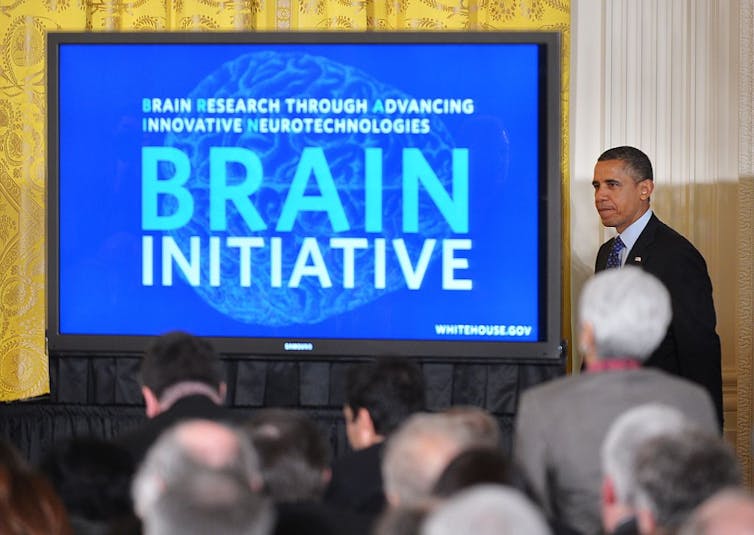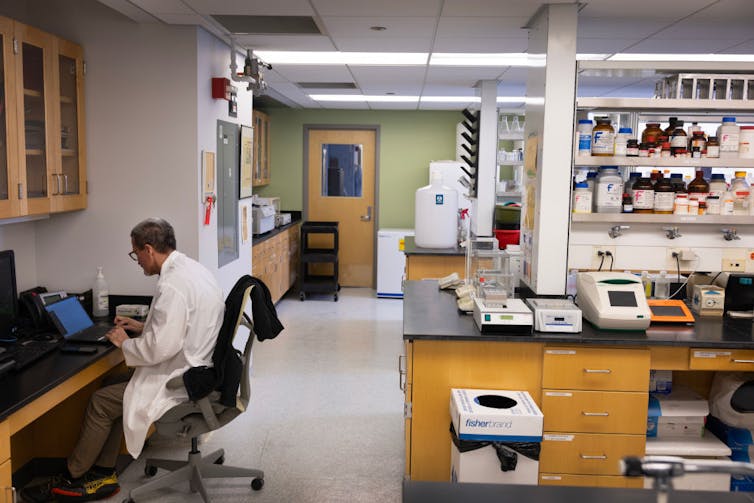Nearly every modern medical treatment can be traced to research funded by the National Institutes of Health: from over-the-counter and prescription medications that treat high cholesterol and pain to protection from infectious diseases such as polio and smallpox.
The remarkable successes of the decades-old partnership between biomedical research institutions and the federal government are so intertwined with daily life that it’s easy to take them for granted.
However, the scientific work driving these medical advances and breakthroughs is in jeopardy. Federal agencies such as the National Institutes of Health and the National Science Foundation are terminating hundreds of active research grants under the current administration’s direction. The administration has also proposed a dramatic reduction in federal support of the critical infrastructure that keeps labs open and running. Numerous scientists and health professionals have noted that changes will have far-reaching, harmful outcomes for the health and well-being of the American people.
The negative consequences of defunding U.S. biomedical research can be difficult to recognize. Most breakthroughs, from the basic science discoveries that reveal the causes of diseases to the development of effective treatments and cures, can take years. Real-time progress can be hard to measure.
Scott Olson/Getty Images
As biomedical researchers studying infectious diseases, viruses and immunology, we and our colleagues see this firsthand in our own work. Thousands of ongoing national and international projects dedicated to uncovering the causes of life-threatening diseases and developing new treatments to improve and save lives are supported by federal agencies such as the NIH and NSF.
Considering a few of the breakthroughs made possible through U.S. federal support can help illustrate not only the significant inroads biomedical research has made for preventing, treating and curing human maladies, but what all Americans stand to lose if the U.S. reduces its investment in these endeavors.
A cure for cancer
The hope and dream of curing cancer unites many scientists, health professionals and affected families across the U.S. After decades of ongoing NIH-supported research, scientists have made significant progress in realizing this goal.
The National Cancer Institute of the NIH is the world’s largest funder of cancer research. This investment has led to advances in cancer treatment and prevention that helped reduce the overall U.S. cancer death rate by 33% from 1991 to 2021.
Basic science research on what causes cancer has led to new strategies to harness a patient’s own immune system to eliminate tumors. For example, all 12 patients in a 2022 clinical trial testing one type of immunotherapy had their rectal cancer completely disappear, without remission or adverse effects.
Another example of progress is the 2024 results of an ongoing clinical trial of a targeted therapy for lung cancer, showing an 84% reduction in the risk of disease progression or death. Similarly, in a study of women who were immunized against the human papillomavirus at age 12 or 13, none developed the disease later. Since the widespread adoption of HPV vaccination, cervical cancer deaths have dropped 62%.
Despite these incredible successes, there is still a long way to go. In 2024, over 2 million people in the U.S. were estimated to be newly diagnosed with cancer, and 611,720 were expected to die from the disease.
Without sustained federal support for cancer research, progress toward curing cancer and reducing its death rate will stall.
Autoimmune and neurodegenerative diseases
Nearly every family is touched in some way by autoimmune and neurodegenerative diseases. Government-funded research has enabled major advances to combat conditions such as rheumatoid arthritis, multiple sclerosis, Parkinson’s and Alzheimer’s disease.
For example, approximately 1 in 5 Americans have arthritis, an autoimmune disease that causes joint swelling and stiffness. A leading cause of disability and economic costs in the U.S., there is no cure for arthritis. But new drugs in development are able to significantly improve symptoms and slow or prevent disease progression.
Researchers are also gaining insight into what causes multiple sclerosis, an autoimmune disease where the immune system attacks the protective covering of nerves and can result in paralysis. Scientists recently found a link between multiple sclerosis and Epstein-Barr virus, a pathogen estimated to infect over 90% of adults around the world. While multiple sclerosis is currently incurable, identifying its underlying cause can provide new avenues for prevention and treatment.

Mandel Ngan/AFP via Getty Images
Alzheimer’s disease causes irreversible nerve damage and is the leading cause of dementia. In 2024, 6.9 million Americans ages 65 and older were living with Alzheimer’s. Most treatments address cognitive and behavioral symptoms. However, two new drugs developed with NIH-supported research and clinical trials were approved in July 2023 and July 2024 to treat early-stage Alzheimer’s. Federal funding is also supporting the development of blood tests for earlier detection of the disease.
None of these breakthroughs are a cure. But they represent important steps forward on the path toward ultimately reducing or eliminating these devastating ailments. Lack of funding will slow or block further progress, leading to the continued rise of the incidence and severity of these conditions.
Infectious diseases and the next pandemic
The world’s capacity to combat infectious disease will also be weakened by cuts to U.S. federal support of biomedical research.
Over the past 50 years, medical and public health advances have led to the eradication of smallpox globally and the elimination of polio in the U.S. HIV/AIDS, once a death sentence, is now a disease that can be managed with medication. Moreover, a new version of treatments called preexposure prophylaxis, or PrEP, offers complete protection against HIV transmission when taken only twice per year.
Similarly, the COVID-19 pandemic highlights the critical role biomedical research plays in responding to public health threats. Increased federal support of science during this time allowed the United States to emerge with new drugs, vaccine platforms with the potential to treat a variety of chronic diseases, and insights on how to effectively detect and respond to pandemic threats.
The ongoing avian influenza outbreak and its spillover into American dairy herds and poultry farms is another pandemic threat looming on the horizon. Rather than build upon infrastructure for outbreak surveillance and preparedness, grants that would allow scientists to better understand long COVID-19, vaccines and other pandemic-related research are being cut. Decreased funding of biomedical research will hamper the U.S.’s ability to respond to the next pandemic, putting everyone at risk.

Scott Olson/Getty Images
Losses from defunding biomedical research
The National Institutes of Health contributed over $100 billion to support research that ultimately led to the development of all new drugs approved from 2010 to 2016 alone. Over 90% of this funding was for basic research into understanding the causes of disease that provides the foundation for new treatments.
Under the new directive to eliminate projects that support or use terms associated with diversity, equity and inclusion, the NIH and other federal agencies have made deep cuts to biomedical research that will directly affect patient lives.
Already, nearly 41% of Americans will be diagnosed with cancer at some point in their lifetime, and nearly 11% with Alzheimer’s. About 1 in 5 Americans will die from heart disease, and nearly 1.4 million will be rushed to an emergency room due to pneumonia from an infectious disease.
Defunding biomedical research will result in a cascade of effects. There will likely be fewer clinical trials, fewer new treatments and fewer lifesaving drugs. Labs will likely shut down, jobs will be lost, and the process of discovery will stall. The U.S.’s health care system, economy and standing as the world’s leader in scientific innovation will likely decline.
Moreover, when the pipelines of scientific progress are turned off, they will not so easily be turned back on. These consequences will affect all Americans and the rest of the world for decades.
University shortfalls directly resulting from cuts to research support will dramatically reduce the capacity of American institutions to educate and provide opportunities for the next generation. Funding cuts have led to the shuttering or heavy reduction of training programs for future scientists.
Graduate students and postdoctoral trainees are the lifeblood of biomedical research. Supporting these young people committed to public service through research and health care is also an investment in medical advancements and public health. But the uncertainty and instability resulting from the divestment of federally funded programs will likely severely deplete the biomedical workforce, crippling the United States’ ability to deliver future biomedical breakthroughs.
By cutting biomedical research funding, Americans and the rest of the world stand to lose new cures, new treatments and an entire generation of researchers.

